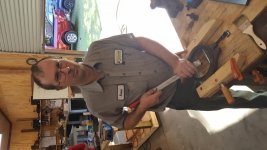BrianB
Hot Rolled
- Joined
- Aug 24, 2006
- Location
- Shelbyville, Ky
This is a playlist of the videos I did regarding the alignmnet and inspection of my small G&L HBM.
Giddings and Lewis Horizontal Boring Mill Alignment and Inspection - YouTube
The machine is I believe a late 40's 340T. It appears to be in pretty good shape. I hope to put it into service soon and then I will know more about how it performs. I go over the best methods I could come up with to get the machine in alignment using fairly standard shop tools. I would love to be able to use lasers or optics to cover the large area but since I don't have access to that type of stuff this is what I did. I appreciate any feedback or ideas on doing this job as well.
Giddings and Lewis Horizontal Boring Mill Alignment and Inspection - YouTube
The machine is I believe a late 40's 340T. It appears to be in pretty good shape. I hope to put it into service soon and then I will know more about how it performs. I go over the best methods I could come up with to get the machine in alignment using fairly standard shop tools. I would love to be able to use lasers or optics to cover the large area but since I don't have access to that type of stuff this is what I did. I appreciate any feedback or ideas on doing this job as well.




